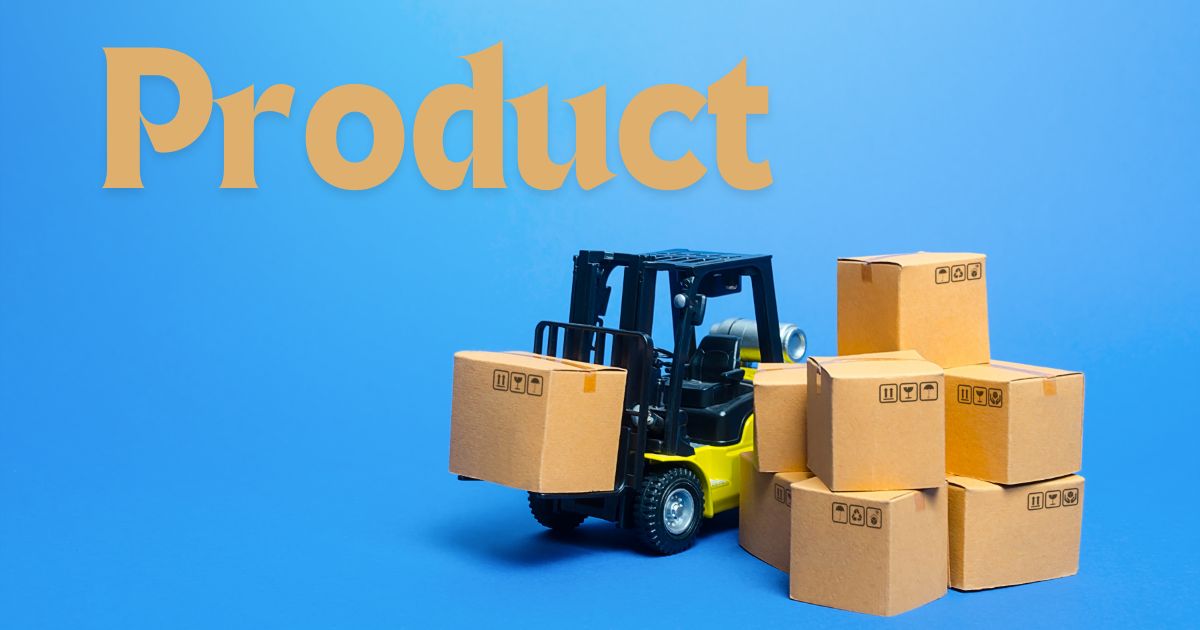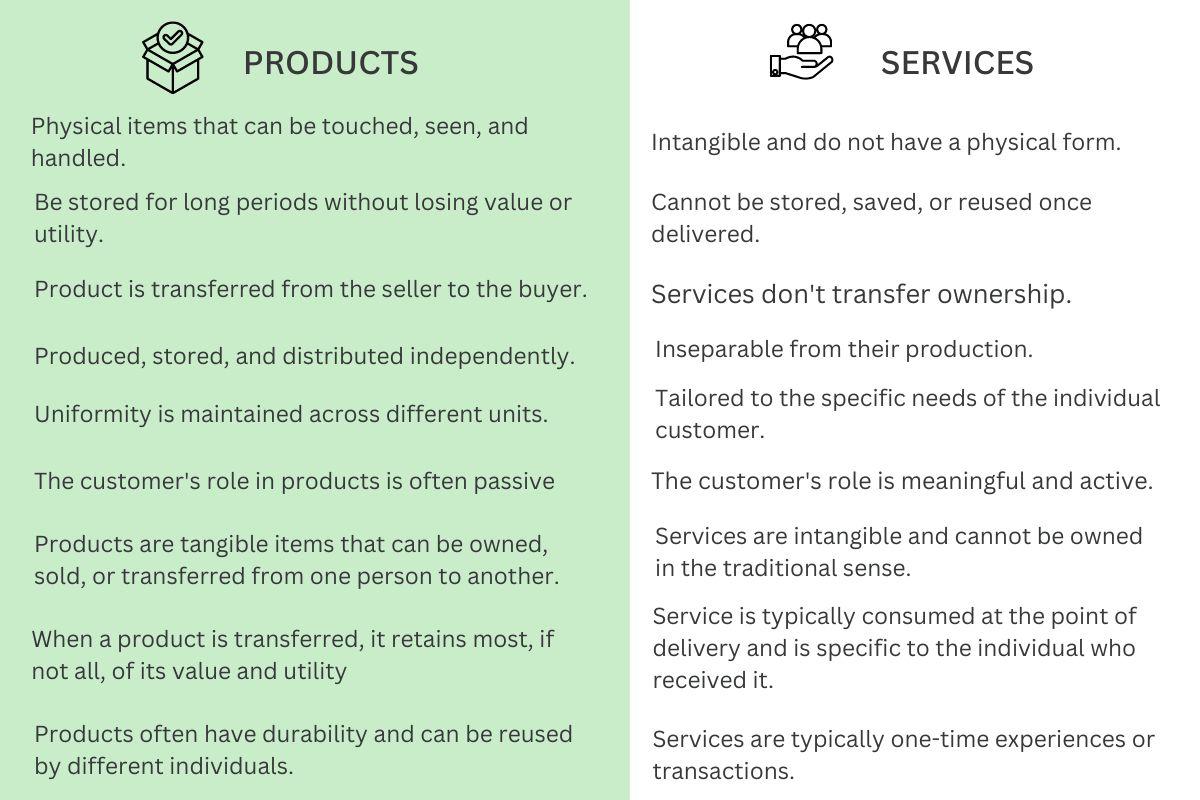Products and Services: Definitions, Differences & Examples
In the modern marketplace, the distinction between products and services can shape consumer choices and business strategies. While both are fundamental to the economy, they differ significantly in their nature, creation, and delivery. Understanding these differences is essential for consumers seeking to make informed decisions and businesses aiming to meet customer needs effectively.
In this article, we will explore the definitions of products and services, highlight their key differences, and provide some examples.
What is the Product?

A product is a tangible item or a bundle of features designed to meet a specific need or desire of consumers. Products can be physical goods, such as electronics, clothing, and food items, or digital items, like software, eBooks, and online courses. They go through a process of design, development, manufacture, and sale in the marketplace.
In business, products are a core offering, and their success often depends on how well they meet the target market's needs.
What is Service?

Services are activities or processes provided by businesses to customers, often in exchange for payment. The effectiveness of a product is judged based on expertise, skills, or resources to meet a specific need.
Services are a fundamental part of the economy, encompassing a wide range of industries, including healthcare, education, finance, hospitality, and more. They concentrate on creating value through actions, expertise, and experiences rather than the transfer of physical goods.
Differences between Products and Services

Products and services are two distinct types of offerings in business, each with unique characteristics:
Tangibility
Tangibility is the primary difference between products and services. Products are tangible items, while services are intangible experiences or actions.
Products are physical items that can be touched, seen, and handled. Therefore, it can be owned, stored, or even transported.
For example, a smartphone, a book, or a car are all tangible products. Consumers can inspect these items before purchasing. Especially products remain with the customer after the transaction is complete.
On the other hand, services are intangible and do not have a physical form. They comprise actions, processes, or performances that provide value without resulting in the ownership of anything physical.
For instance, a haircut, legal consultation, online streaming subscription are services.
Unlike products, services cannot be physically touched or stored; they are consumed when delivered. So, it often relies on the provider's expertise combined with their skill.
Perishability
Most products are non-perishable or have varying degrees of perishability. Physical goods can often be stored for long periods without losing value or utility, depending on the product's nature.
For instance, electronics, furniture, and books can be stored and sold in the future. Even perishable goods, like food, have a limited shelf life, which can be preserved for some time using proper storage techniques.
Services are inherently perishable because they cannot be stored, saved, or reused once delivered. A service is consumed at the moment it is provided, and if it is not used when available, the opportunity to deliver that service is lost.
As an example, when a hotel room goes unbooked for a night or a seat on a flight remains unsold, the revenue potential from that service is permanently lost. Similarly, a missed appointment with a doctor or a live performance cannot be "stocked" for later use.
In essence, the perishability of services means they must be managed in real time to match supply with demand, whereas products can be produced, stored, and sold over time.
Ownership
When a consumer purchases a product, ownership of that product is transferred from the seller to the buyer. It means the buyer gains full rights over the product, allowing them to use, store, resell, or dispose of it as they see fit.
In case you buy a smartphone, you own the device outright. You can use it, sell it to someone else, or trade it for a new model.
Services don't transfer ownership. Instead, when you purchase a service, you are paying for the experience, expertise, or access provided by the service. But you do not own anything tangible after the service is delivered.
As a case in point, when you hire a consultant, you are paying for their advice and expertise during the consultation. However, you do not own the consultant’s knowledge or the service itself after the session is over.
Inseparability
Products are typically produced, stored, and distributed independently of when and where they are consumed. The manufacturing process occurs separately from the point of sale and usage. It is an important factor for the process mass-produced, inventoried, and sold at a later time.
This can be seen when a car is manufactured in a factory, stored in a dealership, and then sold to a customer, who can use it whenever they choose. The production of the car is entirely separate from its purchase and use.
Services are inseparable from their production because they are typically produced and consumed simultaneously. The service provider and the customer are often required to be in the same place, or at least connected in real-time, for the service to be delivered and consumed. The presence and interaction of both parties are essential.
For example, a haircut is a service where the barber and the customer must be present at the same time. The haircut is produced (performed) and consumed (experienced) in the same moment, making the production and consumption inseparable.

Variability
Products are generally standardized, meaning they are produced in a controlled environment where uniformity is maintained across different units. Each product of the same type is nearly identical in quality, features, and performance, regardless of when or where it is produced.
Because of this standardization, the variability in products is low. A product purchased today will likely be the same as one purchased months later, assuming they are from the same production line.
If you look at a smartphone model produced by a manufacturer will be consistent in its features, design, and performance across all units. Customers purchasing the same model can expect the same experience.
Services are often tailored to the specific needs of the individual customer, leading to higher variability. The quality and nature of a service can vary significantly depending on factors like who provides the service, the time, place, context of delivery, and the specific needs or expectations.
Due to the human element in delivering services, variability is higher. Even the same service delivered by the same provider can differ from one instance to another, contingent on various factors like the provider's mood, skill level, and the customer’s interaction.
One example is a dining experience at a restaurant can vary from visit to visit. The quality of the food, service, and ambiance can differ based on the chef, the server, the time of day, and the customer's preferences, resulting in variability in the overall experience.
Customer Involvement
First of all, the customer's role in products is often passive. Customers only need to choose, buy, and use the product with little involvement in the process of creating or providing that product. In contrast, for services, the customer's role is meaningful and active. They are often directly joined in the service delivery process, greatly influencing the outcome and experience.
Customization and personalization are also significant differentiators between products and services. With products, customers often only choose from available options and have little ability to intervene in customizing the product to their liking. However, in services, customers easily personalize and customize the service to their own needs. Customer participation, feedback, and requests shape how the service is delivered.
The level of interaction between customers and providers also differs significantly between products and services. When purchasing products, the interaction mainly takes place during the purchase transaction and sometimes post-purchase support. For services, the interaction is more frequent and continuous, from the pre-service stage to the service delivery, even after the service is completed. Customers need to communicate to express their needs, preferences, and feedback on the service.
Transferability
Products are tangible items that can be owned, sold, or transferred from one person to another. Once purchased, the ownership of the product is transferred to the buyer, who can then resell, gift, or transfer the product to someone else without losing its inherent value or functionality.
Services are intangible and cannot be owned in the traditional sense. They are usually consumed at the time of delivery and are tied to the original buyer or recipient. Because of their nature, services are generally non-transferable. For instance, a haircut or a medical consultation cannot be transferred to another person once delivered.
Value Retention When Transfer
When a product is transferred, it retains most, if not all, of its value and utility, depending on its condition and market demand. The new owner can use the product similarly to the original buyer. For example, a used car or a piece of furniture can be sold or given to another person who can then use it.
The value of a service is typically consumed at the point of delivery and is specific to the individual who received it. Since services are usually personalized or consumed immediately, their value cannot be transferred to another person. For example, a plane ticket may be non-transferable, meaning it cannot be used by anyone other than the person whose name is on the ticket.
Durability and Reusability
Products often have durability and can be reused by different individuals. This reusability enhances their transferability, allowing products to change hands multiple times throughout their lifecycle.
Services are typically one-time experiences or transactions. Once delivered, a service cannot be reused or transferred to another person. For example, a consulting session or an educational course attended by one person cannot be transferred to another individual after completion.
Dive into business topics with our structured course, tailored to both beginners and advanced learners. Please click on the course name below to learn more:
Artificial Intelligence AI Marketing to Grow your Business
In this course, you will learn how to use Artificial Intelligence in your:
Email marketing to increase open rates and optimize delivery.
Content marketing, to write content 5X faster.
Chat and messaging to automate customer service and sales.
Social Media Marketing automatically creates engaging content for your fans in minutes!
SEO to optimize your website and rank #1 on Google.
Analytics & Reports to help you understand customer behavior and make decisions faster.
ChatGPT: You will dominate ChatGPT Marketing by using it in your daily activities to save hours!
Business Branding With Personality: Build An Authentic Brand
If you want to understand your audience on a deeper level, their fears, desires, characteristics and behaviours, and you want to build a brand personality that engages them on an emotional level, then this is the course for you.
One of the first considerations when building a business brand and a business strategy should be; how do I connect with my audience in a way that seems organic and natural. So the see the business like a person.
Master the Shopper Experience to build your retail business.
If you work in the world of retail, then this course is for you. It explains in depth the Retail Trifecta - the three elements that are integral to success, and increased profits, in retail.
Presented by retail marketing guru, Kevin Moore - a man who walks thousands of stores around the world each year - the course brings to life, with real-world examples, the steps needed to be successful in retail. Whether you own your own store/s, work as an associate in retail or manufacture and distribute through stores, this course contains essential knowledge that will help you in your business.
Conclusion
The distinction between products and services is foundational to understanding how businesses operate and how consumers engage with the marketplace. Products, being tangible and transferable, offer a different kind of value compared to services, which are intangible and often personalized. As the lines between products and services continue to blur in today’s evolving market, understanding these core concepts remains essential for success in any industry.
Are you looking to develop your business products or services? Or simply learn more from leading experts? One way is to sign up for Skilltrans courses. We have a variety of courses that can meet your needs.

Meet Hoang Duyen, an experienced SEO Specialist with a proven track record in driving organic growth and boosting online visibility. She has honed her skills in keyword research, on-page optimization, and technical SEO. Her expertise lies in crafting data-driven strategies that not only improve search engine rankings but also deliver tangible results for businesses.



